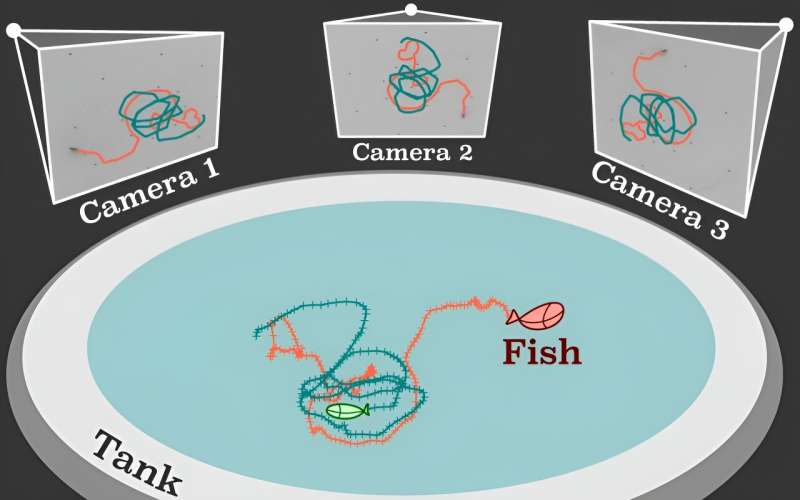This article has been reviewed according to Science X's editorial process and policies. Editors have highlighted the following attributes while ensuring the content's credibility:
fact-checked
peer-reviewed publication
trusted source
proofread
How many zebrafish constitute a school? 'Three,' say physicists

Physicists are also interested in fish—above all when they are researching the formation of structures. A research team from Heinrich Heine University Düsseldorf (HHU) and the University of Bristol (United Kingdom) has examined the schooling behavior of zebra danio (Danio rerio, also known as "zebrafish") using methods from the field of multi-particle physics. They explain that groups of just three fish already move in a similar way to large schools while, by contrast, two fish display completely different behavior.
The saying "three is a crowd" seems not only to apply to "The Three Investigators" and the three musketeers. In various scientific phenomena—such as primary colors or spatial dimensions—three options are also enough to characterize different states.
Physicists have now investigated how various large groups of living creatures behave. They wanted to know the minimum group size needed for the movement patterns of the individual members to change and become a coordinated group movement. And three does indeed seem to be the key number for zebrafish.
The physicists fitted an aquarium in Bristol with synchronized cameras to measure the three-dimensional swim trajectories of their zebrafish. They systematically recorded these trajectories for various group sizes—two, three, four and fifty fish.
In the next step, they then looked for instances of order in the swim trajectories. They found various movement patterns: The fish either all swam in the same direction or they swam round in a circle together. When they moved in the same direction, they either swam next to each other or one after another.
An isolated pair of fish prefers to move one after another—one fish leads, the other follows. However, three fish swim next to each other—it seems that none of them wants to be last. And: This habit of swimming next to each other is also characteristic of a large school of fish.
The researchers then also marked small sub-groups within a large school. They established that groups of three within the school move in a very similar way to an isolated group of three. However, where they only marked two neighbors, they behaved differently in the school than as an isolated pair.
Dr. Alexandra Zampetaki from Düsseldorf (now Vienna), co-lead author with Dr. Yushi Yang of the study now published in Nature Communications, notes, "Practically, three fish form a school, but two are not enough."
"This simple finding initially only applies to zebrafish. However, the concepts could also be transferred to other examples of fauna," says corresponding author Professor Dr. C. Patrick Royall from the University of Bristol, who now works at the EPSCI in Paris. "These include schools of other fish such as goldfish or sardines, as well as flocks of birds such as starling murmurations and swarms of insects such as dancing mosquitos."
The idea for the joint research project arose over the course of several visits by Professor Royall.
"Applying traditional methods and concepts from the theory of fluids such as pair and triplet correlations to fish was a new challenge, as these concepts originate from the thermodynamic equilibrium and a living school of fish is far from being in a state of equilibrium," says Löwen, Head of the Institute for Theoretical Physics II at HHU.
The fundamental classification of the many-body effects was undertaken in Düsseldorf. In addition, Dr. Alexandra Zampetaki simulated the fish trajectories. "We modified our model to enable realistic simulation of the swimming motion of the fish. The simulation confirmed the experimental finding that 'three constitute a school.'"
Looking to the future, the researchers are aiming to apply their findings to the group behavior of people and how they behave, for example, at parties or mass gatherings. Löwen says, "We will see whether the simple limit of the number three then also applies."
More information: Alexandra Zampetaki et al, Dynamical order and many-body correlations in zebrafish show that three is a crowd, Nature Communications (2024). DOI: 10.1038/s41467-024-46426-1
Journal information: Nature Communications
Provided by Heinrich-Heine University Duesseldorf





















